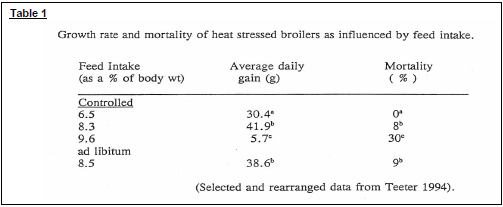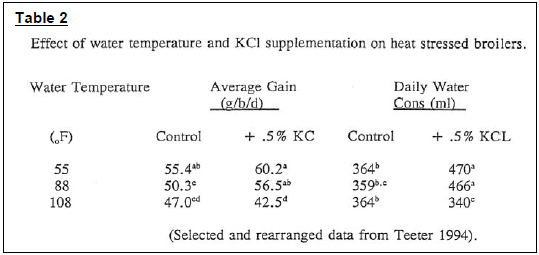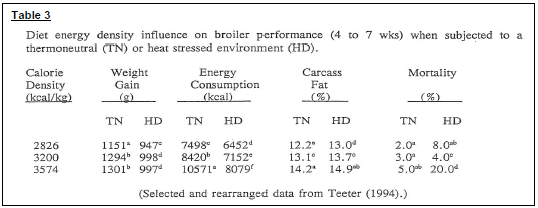



Heat Stress
In Tech Info 6 from the Canadian Poultry Industry Council, John Summers describes thermal balance and thermo-regulation in poultry. He then explains aspects of water and house climate management to alleviate the effects of heat stress.The following has been summarized in part, from an article by Dr Robert Teeter, Oklahoma State University, in a recent issue of Poultry Digest. Dr Teeter has done a lot of work in the area of heat stress in poultry and is certainly one of the leading authorities on this subject in North America. For those interested in more detail and good reference to the work reported, refer to his article in Poultry Digest, May 1994, p10.
Heat stress is a problem with any poultry production unit since high product output (whether meat or eggs) leads to greater metabolic activity and thus greater body heat production. This is especially true for the chicken broiler since it is growing at a rapid rate and while heat production is thus increasing its ability to dissipate heat is diminishing as its body surface, in relation to body weight, is decreasing.
Birds have only two main avenues to get rid of body heat as they do not sweat. In a comfortable environment the bird gets rid of heat by non-evaporative cooling. This is an energetically efficient means to dissipate heat. Birds increase blood flow to the body surface and thus heat is lost due to the temperature gradient between the bird and its’ environment. When the temperature rises above the thermal neutral zone of the bird, (above 32°C and above 50% relative humidity) the bird then resorts to evaporative cooling. The bird begins to pant and thus exhale moist warm air. The temperature gradient between the environment and the body temperature of the bird is again important in influencing the amount of heat that can be dissipated. Of even more importance is the relative humidity of the pen. Above 70% relative humidity it is almost impossible for the bird to lose a significant amount of heat through panting as the moisture gradient between expired and pen air is similar.
Another problem with the bird resorting to evaporative cooling is that energy is required to pant and thus heat is produced as respiration ratio increases. Hence, in order to get rid of heat through respiration there is a cost in metabolic heat production that the bird must contend with. The comfort zone for poultry declines from around 32°C at hatching to 24°C at 4 weeks of age. Therefore poultry producers seldom worry about heat stress with young birds. In planning a program to alleviate heat stress for broilers there are a number of factors to consider as these can all affect thermobalance. The body weight of the bird is an important consideration as well as type of diet, management practices and previous heat exposure. All factors must be considered not so much to avoid heat stress, but to implement proper procedures to help minimize the affects of heat stress.
Thermobalance
Thermobalance is the sum of heat production and heat dissipation. Heat production of broilers is particularly high as they are consuming high energy feeds with an energy retention of less than 40%, thus 60% of the dietary energy must appear as heat production. In an attempt to lower heat production, the bird in a heat stress situation will reduce feed intake. However, the poultry-man, who is seeking to maximize growth, will resort to higher energy diets, running feeders, etc. to try to encourage higher nutrient intake at this time.
There is little information to suggest that encouraging feed intake during heat stress will increase the production of lean body mass. The effects of heat stress per se reduce growth potential then efforts to increase feed intake at this time many only result in increased carcass fatness. There are a number of reports indicating that heat stressed broilers are not only lighter but also have increased carcass as well as abdominal fat content. It has been suggested that the lipogenic response, with heat stressed broilers, may be a form of acclimatization as the net heat produced with the laying down of depot fat would be less than if the energy was utilized for growth.
There is no question but that the growth rate of heat stressed broilers can be increased through various dietary manipulations. However, invariably along with increased feed intake, mortality is always higher (Table 1).

From the above table it is obvious that encouraging broilers to consume more feed will result in heavier weight birds, however, the significant increase in mortality may be a high price to pay for a little extra weight.
Temperature Regulation
Non-Evaporative Cooling
All poultry use non-evaporative cooling as a means of getting rid of excess body heat. It is suggested that the peripheral blood shunting probably reduces digestive rate, thus lowering metabolism and hence heat output. It is obvious that in recovery periods feed intake will increase with a concomitant rise in heat production. Thus the producer must utilize proper ventilation during the cooler evenings to remove heat from the buildings so that the bird moves as quickly as possible from evaporative cooling (during the heat stressed period of the day) to non-evaporative cooling, which as mentioned earlier is a more energetic efficient heat disposal system.
Evaporative Cooling
As non-evaporative cooling diminishes, due to increased pen temperatures, evaporative cooling takes over as the main means of getting rid of body heat.
The latent heat of vaporization for water at 41°C is 574 cal/ml while heat absorbed by warming consumed water to body temperature is 20 cal/ml. Thus, during heat stress, it is obvious that panting is by far the most important avenue for getting rid of excess body heat. Relying on the bird to handle the increased heat load produced by higher respiration rates, without trying to assist it in handling the heat dissipation problem, is not the proper management decision.
Respiration rate increased from 25 breaths per minute, in a normal environment, to 260 when acute stress is encountered. Such a high rate of respiration can markedly increase the heat load through higher metabolic activity. Another consequence of increased respiration is the resulting respiratory alkalosis.
Relative humidity can markedly affect evaporative cooling potential during heat stress. As the relative humidity rises, the ease with which the bird can evaporate water by exhaling declines (respiration efficiency declines) and body temperature will increase unless heat production is reduced. These relationships must be considered for optimal management of ventilation fans, foggers etc. Usually foggers are of little value if the relative humidity exceeds 70%.
Management Options to Combat Heat Stress
Housing
Type of housing is an important consideration for a well ventilated and heat controlled facility. However, the main concern is more with the biological approaches as little can be done to alter house design in the midst of a pending heat stress.
Feeding
As mentioned previously, the greatest proportion of economic loss with heat stress is the result of lower feed intake. There are a number of ways to encourage feed intake such as running feeders, pelleting feeds, using meal feeding, continuous lighting programs, high density diets, etc. which may help to off set, to some extent, the reduced growth rate. However, as mentioned previously increased feed intake results in increased heat production with the strong possibility of significantly increasing mortality.
Fasting
Since increased feed intake increases heat output, reducing feed intake will obviously reduce heat output. It has been well documented that fasting birds for up to 72 hours will increase survival time. Fasting intervals as short as 3 hours prior to the initiation of heat stress have also been shown to enhance bird survival. However, removing feed after the onset of heat stress is of little value.
Time is required for feed to clear the digestive tract and thus reduce heat output. Fasting must take place prior to the onset of heat stress. Fasting for 6 to 8 hours prior to the hot time of the day should give the optimum results since the bird will consume little during the heat stress period and thus total length of time off feed could be 12 to 14 hours.
While people may worry about low feed intake and reduced growth during heat stress, birds will compensate during the cooler part of the evening, or if there are several days of cooler weather before the birds are marketed, compensatory growth will usually bring weight up to near normal levels.
Acid-Base-Balance
Enhanced respiration rate during heat stress results in carbon dioxide loss and acid-base balance alterations. However, these effects of altered acid-base balance are, at present, little understood. Weight gain has been enhanced with water carbonation or supplementation with acids such as ammonium chloride (NH4Cl) or hydrochloric acid (HCl), suggesting that acid-base balance is critical for maximizing weight gain. While a number of additives have been used to try and alter acid/base balance all seem to act by increasing water intake. Thus, while water intake is an important consideration there is also an acid-base balance effect which must be considered.
Water Management
Water consumption is an important consideration with heat stressed birds. However, its importance is sometimes down played by the fact that 80% of the bird’s heat production during heat stress is dissipated via panting (evaporative cooling). Addition of various salts to water alters the bird’s osmotic balance, resulting in increased water consumption, thus influencing water balance during heat stress. No growth response has been observed by adding salts to drinking water for non-heat stressed birds.
Research has shown that increased water consumption benefits the bird by acting as a heat receptor as well as increasing the amount of heat dissipated per breath. Such thermobalance effects are principally observed when water temperature falls below 28°C. Birds in positive water balance are better able to maintain normal body temperature. This has special significance for the commercial broiler as heat stress increases urine production, independent of water intake, thus forcing birds to sustain higher water consumption levels than required to simply replace water loss due to evaporative cooling.
Data indicated that increasing water consumption by 20% over basal levels (by acid treatment or reduced water temperatures) can increase heat loss per breath by as much as 30%. Reasons for such a response are speculative but it could be that genetic selection for our modern broilers, occurs in the presence of continuous availability of feed and water. Thus, such birds may have lost the capacity to conserve water, during stress periods, such as is observed with most wild birds.
Drinking Water Temperature
There are significant interactions between adding salt to drinking water and water temperature. If the temperature of the drinking water is below that of the bird’s body, adding potassium chloride (KCl) will increase consumption. However, if the temperature of the water equals that of the bird’s body no response in water intake is noted with KCl addition. Lowering the temperature of the water, with no salt addition, also improves water intake. Indeed water temperature and KCl effects appear to be additive. Such responses can be noted in Table 2.

Mineral Fortification
During heat stress mineral excretion via the urine and feces is increased. Whether specific benefits with mineral supplementation exist, independent of their effect on water intake, is not known. However, it would appear that potassium based salt mixtures are superior to sodium when added to drinking water.
Ration Composition
A number of dietary changes have been evaluated for their effect in reducing heat stress. The addition of dietary fat is one that has been reported by several workers to give an increase in growth rate. The “fat effect” is supposed to be mediated by less waste heat produced in metabolizing fat. Thus, more energy is partitioned into productive purposes. Hence, the net affect of feeding fat is to make more dietary energy available to the bird. Research has shown that increased energy intake, during heat stress, may increase growth rate, but invariably at the cost of higher mortality. Thus, again one must choose between birds of heavier weight or increased mortality. This is demonstrated in Table 3.

Protein Consideration
This is an area where a fair bit of controversy exists. There are those who recommend increasing dietary protein level and those that recommend reduced levels with improved essential amino acid balance. There appears to be sufficient research to suggest that reduced protein is the avenue of choice as this has been shown to improve growth and enhance survivability.
Growth Promotants
Growth promotants (growth promoters) have, amongst other things, been credited by some in reducing gastrointestinal tract mass. Since the gastrointestinal tract represents a significant source of metabolic heat one might anticipate a significant interaction with heat stress. There is limited work to indicate that some antibiotics do result in enhancing the performance of heat stressed broilers. Whether this is an effect of their action in reducing gut contents is not known.
There are many factors to consider in designing an effective program to alleviate the detrimental affects of heat stress. When considering possible approachs to take, one should be conscious of their effect on the thermobalance of the bird. While an increase in thermobalance may result in enhanced gain there is no question but that mortality is increased. On the other hand decreased thermobalance will help reduce mortality but often results in reduced weight gain. The producer must, through past experience, try to achieve the proper thermobalance to maximize the economics of his flocks.








